Case Study: Organisational Behaviour and Effective Leadership Analysis
VerifiedAdded on 2023/01/18
|12
|2564
|83
Case Study
AI Summary
This case study analyzes a scenario involving conflict between a senior manager and junior managers within an organization, primarily stemming from differing perspectives on work policies and discipline. The analysis identifies the conflict as a process conflict, evaluating its constructive nature and suggesting collaboration as a key resolution strategy. The study explores the importance of interpersonal skills, courage, conflict management, decision-making, and area expertise for effective leadership. It also outlines the strengths and weaknesses of effective leaders, including confidence, inspiration, commitment, accountability, and creativity, while also acknowledging weaknesses such as multitasking and lack of trust. Furthermore, the document details the benefits of various leadership styles, including autocratic, bureaucratic, democratic, laissez-faire, and charismatic leadership, offering insights into their applications and outcomes. The assignment emphasizes the importance of ethical considerations, mediation, and understanding diverse perspectives for successful conflict resolution and team management within organizations.
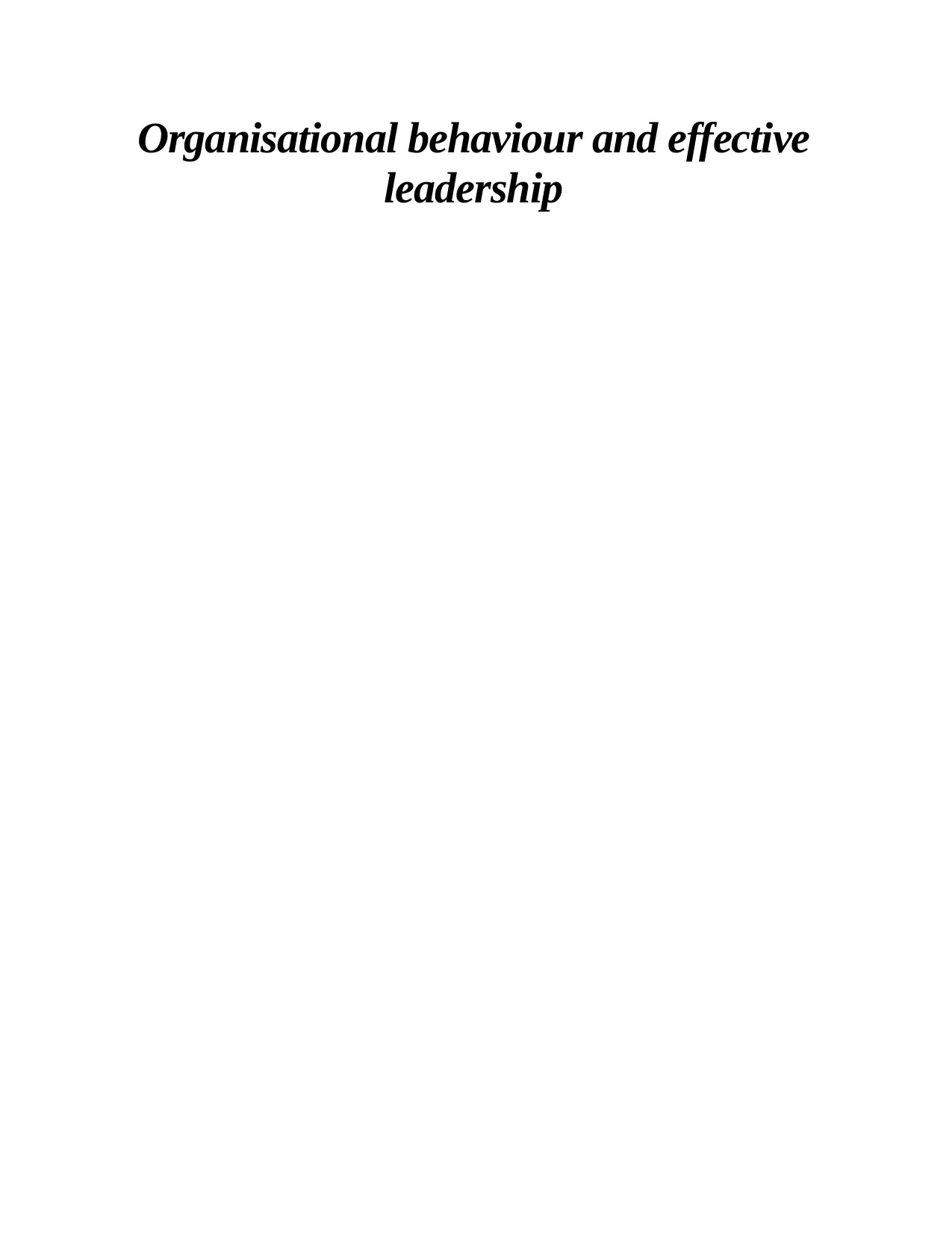
Organisational behaviour and effective
leadership
leadership
Paraphrase This Document
Need a fresh take? Get an instant paraphrase of this document with our AI Paraphraser
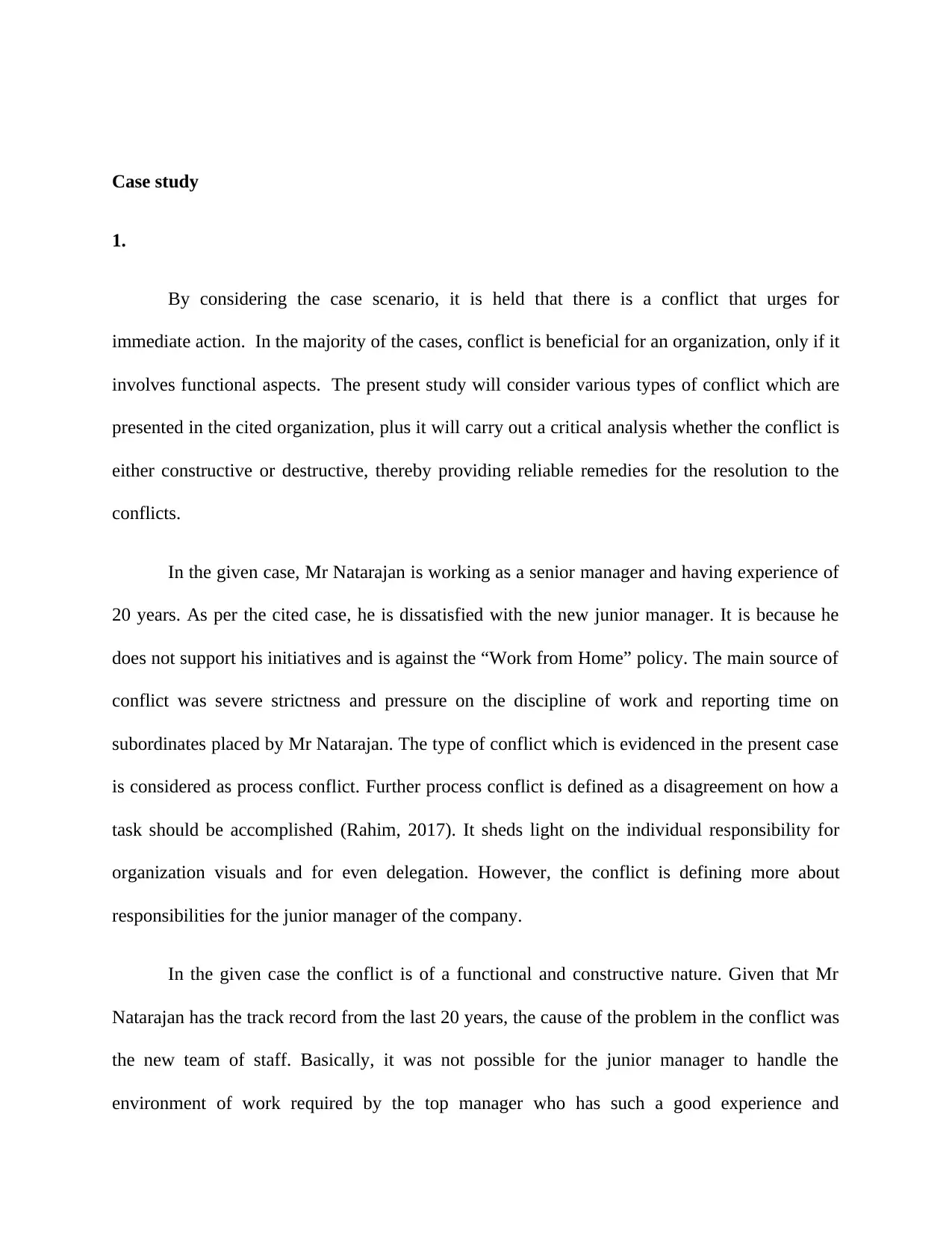
Case study
1.
By considering the case scenario, it is held that there is a conflict that urges for
immediate action. In the majority of the cases, conflict is beneficial for an organization, only if it
involves functional aspects. The present study will consider various types of conflict which are
presented in the cited organization, plus it will carry out a critical analysis whether the conflict is
either constructive or destructive, thereby providing reliable remedies for the resolution to the
conflicts.
In the given case, Mr Natarajan is working as a senior manager and having experience of
20 years. As per the cited case, he is dissatisfied with the new junior manager. It is because he
does not support his initiatives and is against the “Work from Home” policy. The main source of
conflict was severe strictness and pressure on the discipline of work and reporting time on
subordinates placed by Mr Natarajan. The type of conflict which is evidenced in the present case
is considered as process conflict. Further process conflict is defined as a disagreement on how a
task should be accomplished (Rahim, 2017). It sheds light on the individual responsibility for
organization visuals and for even delegation. However, the conflict is defining more about
responsibilities for the junior manager of the company.
In the given case the conflict is of a functional and constructive nature. Given that Mr
Natarajan has the track record from the last 20 years, the cause of the problem in the conflict was
the new team of staff. Basically, it was not possible for the junior manager to handle the
environment of work required by the top manager who has such a good experience and
1.
By considering the case scenario, it is held that there is a conflict that urges for
immediate action. In the majority of the cases, conflict is beneficial for an organization, only if it
involves functional aspects. The present study will consider various types of conflict which are
presented in the cited organization, plus it will carry out a critical analysis whether the conflict is
either constructive or destructive, thereby providing reliable remedies for the resolution to the
conflicts.
In the given case, Mr Natarajan is working as a senior manager and having experience of
20 years. As per the cited case, he is dissatisfied with the new junior manager. It is because he
does not support his initiatives and is against the “Work from Home” policy. The main source of
conflict was severe strictness and pressure on the discipline of work and reporting time on
subordinates placed by Mr Natarajan. The type of conflict which is evidenced in the present case
is considered as process conflict. Further process conflict is defined as a disagreement on how a
task should be accomplished (Rahim, 2017). It sheds light on the individual responsibility for
organization visuals and for even delegation. However, the conflict is defining more about
responsibilities for the junior manager of the company.
In the given case the conflict is of a functional and constructive nature. Given that Mr
Natarajan has the track record from the last 20 years, the cause of the problem in the conflict was
the new team of staff. Basically, it was not possible for the junior manager to handle the
environment of work required by the top manager who has such a good experience and
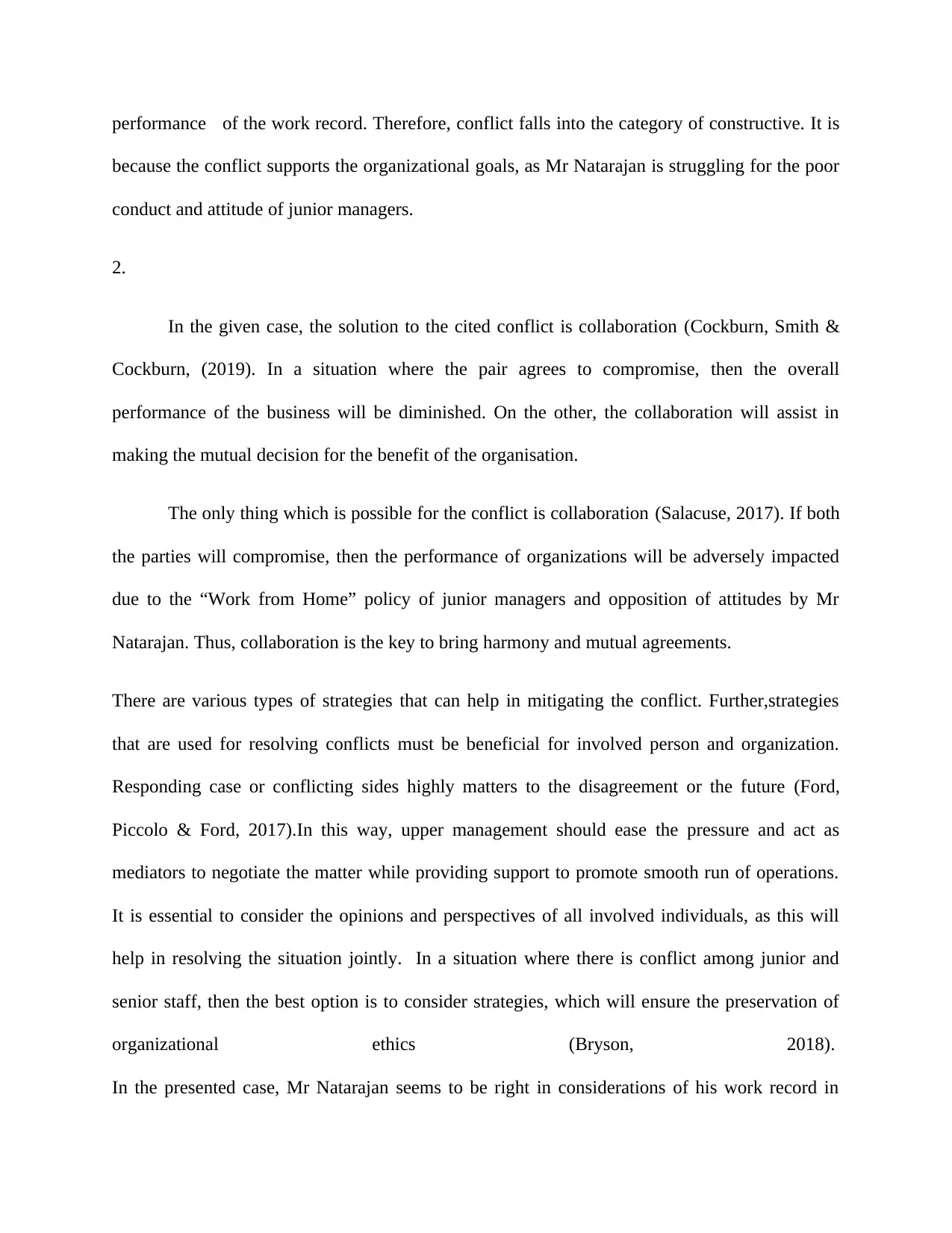
performance of the work record. Therefore, conflict falls into the category of constructive. It is
because the conflict supports the organizational goals, as Mr Natarajan is struggling for the poor
conduct and attitude of junior managers.
2.
In the given case, the solution to the cited conflict is collaboration (Cockburn, Smith &
Cockburn, (2019). In a situation where the pair agrees to compromise, then the overall
performance of the business will be diminished. On the other, the collaboration will assist in
making the mutual decision for the benefit of the organisation.
The only thing which is possible for the conflict is collaboration (Salacuse, 2017). If both
the parties will compromise, then the performance of organizations will be adversely impacted
due to the “Work from Home” policy of junior managers and opposition of attitudes by Mr
Natarajan. Thus, collaboration is the key to bring harmony and mutual agreements.
There are various types of strategies that can help in mitigating the conflict. Further,strategies
that are used for resolving conflicts must be beneficial for involved person and organization.
Responding case or conflicting sides highly matters to the disagreement or the future (Ford,
Piccolo & Ford, 2017).In this way, upper management should ease the pressure and act as
mediators to negotiate the matter while providing support to promote smooth run of operations.
It is essential to consider the opinions and perspectives of all involved individuals, as this will
help in resolving the situation jointly. In a situation where there is conflict among junior and
senior staff, then the best option is to consider strategies, which will ensure the preservation of
organizational ethics (Bryson, 2018).
In the presented case, Mr Natarajan seems to be right in considerations of his work record in
because the conflict supports the organizational goals, as Mr Natarajan is struggling for the poor
conduct and attitude of junior managers.
2.
In the given case, the solution to the cited conflict is collaboration (Cockburn, Smith &
Cockburn, (2019). In a situation where the pair agrees to compromise, then the overall
performance of the business will be diminished. On the other, the collaboration will assist in
making the mutual decision for the benefit of the organisation.
The only thing which is possible for the conflict is collaboration (Salacuse, 2017). If both
the parties will compromise, then the performance of organizations will be adversely impacted
due to the “Work from Home” policy of junior managers and opposition of attitudes by Mr
Natarajan. Thus, collaboration is the key to bring harmony and mutual agreements.
There are various types of strategies that can help in mitigating the conflict. Further,strategies
that are used for resolving conflicts must be beneficial for involved person and organization.
Responding case or conflicting sides highly matters to the disagreement or the future (Ford,
Piccolo & Ford, 2017).In this way, upper management should ease the pressure and act as
mediators to negotiate the matter while providing support to promote smooth run of operations.
It is essential to consider the opinions and perspectives of all involved individuals, as this will
help in resolving the situation jointly. In a situation where there is conflict among junior and
senior staff, then the best option is to consider strategies, which will ensure the preservation of
organizational ethics (Bryson, 2018).
In the presented case, Mr Natarajan seems to be right in considerations of his work record in
⊘ This is a preview!⊘
Do you want full access?
Subscribe today to unlock all pages.

Trusted by 1+ million students worldwide
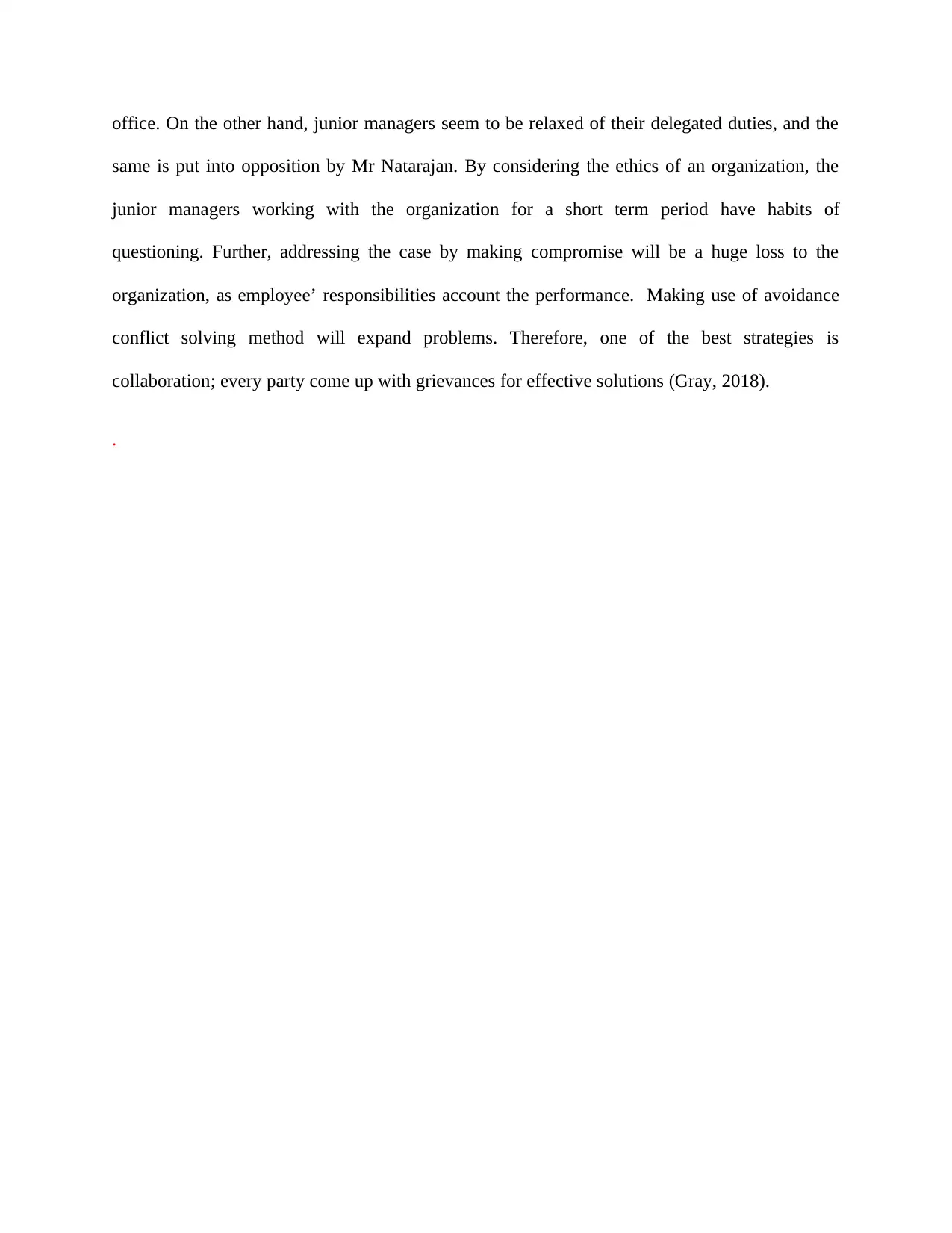
office. On the other hand, junior managers seem to be relaxed of their delegated duties, and the
same is put into opposition by Mr Natarajan. By considering the ethics of an organization, the
junior managers working with the organization for a short term period have habits of
questioning. Further, addressing the case by making compromise will be a huge loss to the
organization, as employee’ responsibilities account the performance. Making use of avoidance
conflict solving method will expand problems. Therefore, one of the best strategies is
collaboration; every party come up with grievances for effective solutions (Gray, 2018).
.
same is put into opposition by Mr Natarajan. By considering the ethics of an organization, the
junior managers working with the organization for a short term period have habits of
questioning. Further, addressing the case by making compromise will be a huge loss to the
organization, as employee’ responsibilities account the performance. Making use of avoidance
conflict solving method will expand problems. Therefore, one of the best strategies is
collaboration; every party come up with grievances for effective solutions (Gray, 2018).
.
Paraphrase This Document
Need a fresh take? Get an instant paraphrase of this document with our AI Paraphraser
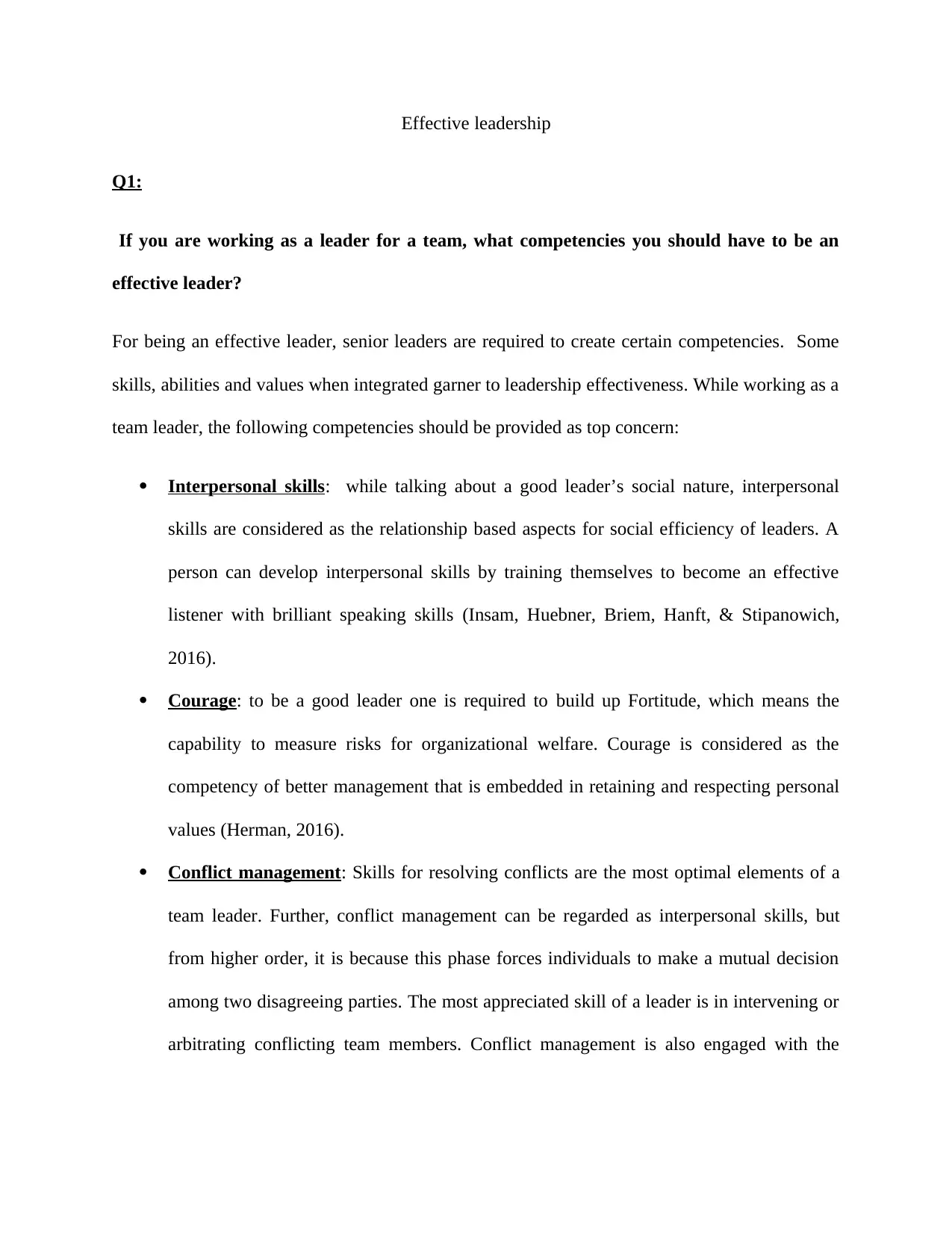
Effective leadership
Q1:
If you are working as a leader for a team, what competencies you should have to be an
effective leader?
For being an effective leader, senior leaders are required to create certain competencies. Some
skills, abilities and values when integrated garner to leadership effectiveness. While working as a
team leader, the following competencies should be provided as top concern:
Interpersonal skills: while talking about a good leader’s social nature, interpersonal
skills are considered as the relationship based aspects for social efficiency of leaders. A
person can develop interpersonal skills by training themselves to become an effective
listener with brilliant speaking skills (Insam, Huebner, Briem, Hanft, & Stipanowich,
2016).
Courage: to be a good leader one is required to build up Fortitude, which means the
capability to measure risks for organizational welfare. Courage is considered as the
competency of better management that is embedded in retaining and respecting personal
values (Herman, 2016).
Conflict management: Skills for resolving conflicts are the most optimal elements of a
team leader. Further, conflict management can be regarded as interpersonal skills, but
from higher order, it is because this phase forces individuals to make a mutual decision
among two disagreeing parties. The most appreciated skill of a leader is in intervening or
arbitrating conflicting team members. Conflict management is also engaged with the
Q1:
If you are working as a leader for a team, what competencies you should have to be an
effective leader?
For being an effective leader, senior leaders are required to create certain competencies. Some
skills, abilities and values when integrated garner to leadership effectiveness. While working as a
team leader, the following competencies should be provided as top concern:
Interpersonal skills: while talking about a good leader’s social nature, interpersonal
skills are considered as the relationship based aspects for social efficiency of leaders. A
person can develop interpersonal skills by training themselves to become an effective
listener with brilliant speaking skills (Insam, Huebner, Briem, Hanft, & Stipanowich,
2016).
Courage: to be a good leader one is required to build up Fortitude, which means the
capability to measure risks for organizational welfare. Courage is considered as the
competency of better management that is embedded in retaining and respecting personal
values (Herman, 2016).
Conflict management: Skills for resolving conflicts are the most optimal elements of a
team leader. Further, conflict management can be regarded as interpersonal skills, but
from higher order, it is because this phase forces individuals to make a mutual decision
among two disagreeing parties. The most appreciated skill of a leader is in intervening or
arbitrating conflicting team members. Conflict management is also engaged with the
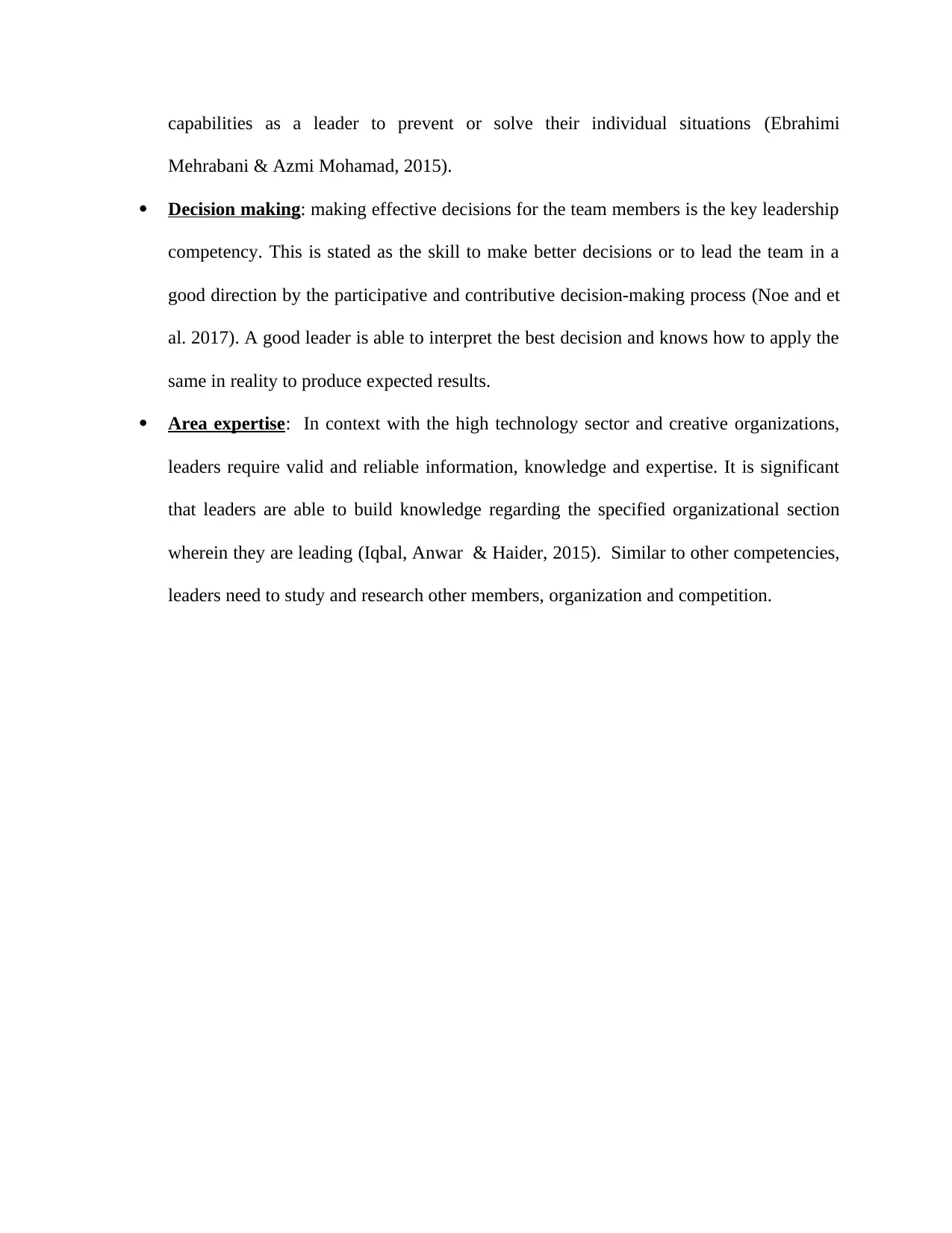
capabilities as a leader to prevent or solve their individual situations (Ebrahimi
Mehrabani & Azmi Mohamad, 2015).
Decision making: making effective decisions for the team members is the key leadership
competency. This is stated as the skill to make better decisions or to lead the team in a
good direction by the participative and contributive decision-making process (Noe and et
al. 2017). A good leader is able to interpret the best decision and knows how to apply the
same in reality to produce expected results.
Area expertise: In context with the high technology sector and creative organizations,
leaders require valid and reliable information, knowledge and expertise. It is significant
that leaders are able to build knowledge regarding the specified organizational section
wherein they are leading (Iqbal, Anwar & Haider, 2015). Similar to other competencies,
leaders need to study and research other members, organization and competition.
Mehrabani & Azmi Mohamad, 2015).
Decision making: making effective decisions for the team members is the key leadership
competency. This is stated as the skill to make better decisions or to lead the team in a
good direction by the participative and contributive decision-making process (Noe and et
al. 2017). A good leader is able to interpret the best decision and knows how to apply the
same in reality to produce expected results.
Area expertise: In context with the high technology sector and creative organizations,
leaders require valid and reliable information, knowledge and expertise. It is significant
that leaders are able to build knowledge regarding the specified organizational section
wherein they are leading (Iqbal, Anwar & Haider, 2015). Similar to other competencies,
leaders need to study and research other members, organization and competition.
⊘ This is a preview!⊘
Do you want full access?
Subscribe today to unlock all pages.

Trusted by 1+ million students worldwide
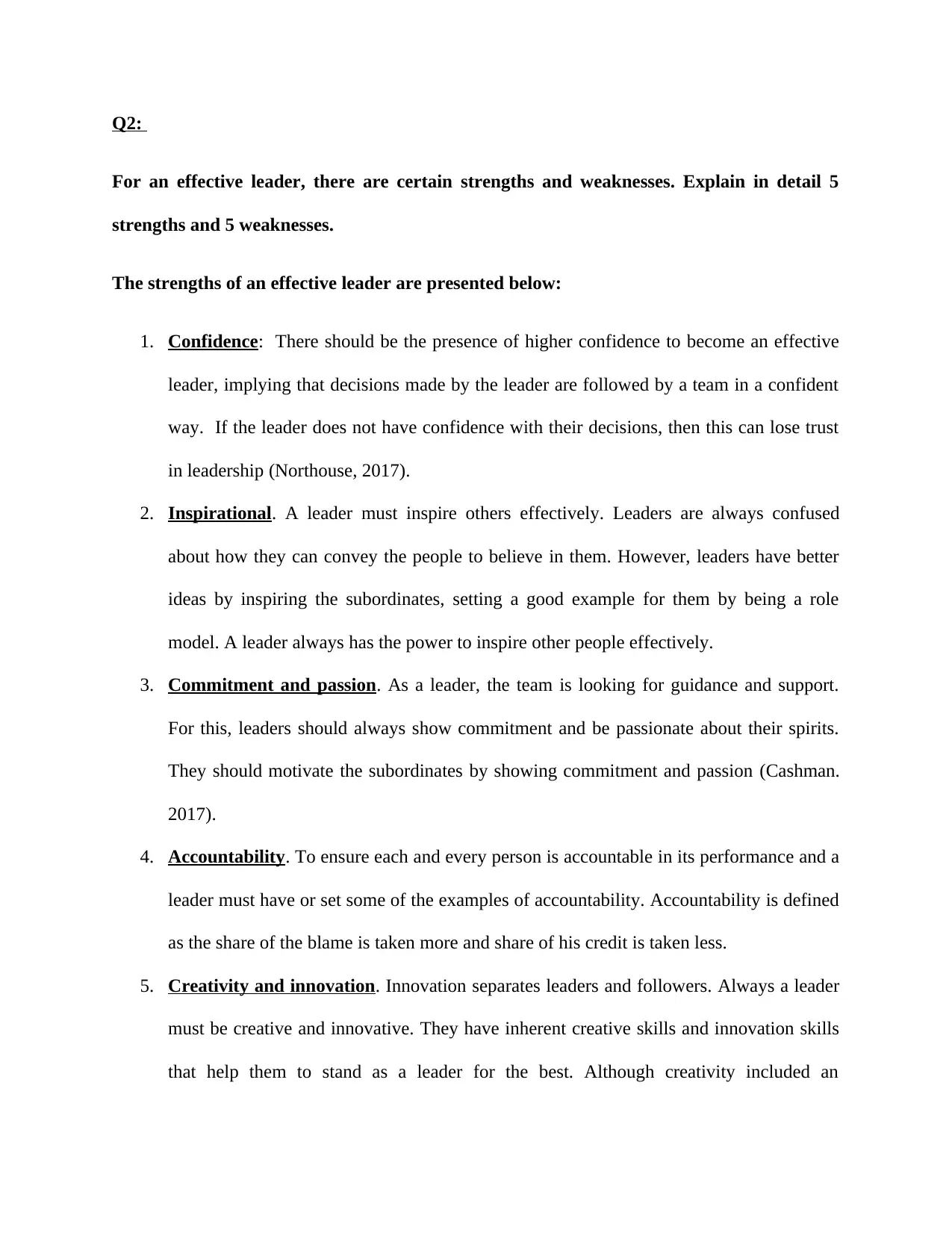
Q2:
For an effective leader, there are certain strengths and weaknesses. Explain in detail 5
strengths and 5 weaknesses.
The strengths of an effective leader are presented below:
1. Confidence: There should be the presence of higher confidence to become an effective
leader, implying that decisions made by the leader are followed by a team in a confident
way. If the leader does not have confidence with their decisions, then this can lose trust
in leadership (Northouse, 2017).
2. Inspirational. A leader must inspire others effectively. Leaders are always confused
about how they can convey the people to believe in them. However, leaders have better
ideas by inspiring the subordinates, setting a good example for them by being a role
model. A leader always has the power to inspire other people effectively.
3. Commitment and passion. As a leader, the team is looking for guidance and support.
For this, leaders should always show commitment and be passionate about their spirits.
They should motivate the subordinates by showing commitment and passion (Cashman.
2017).
4. Accountability. To ensure each and every person is accountable in its performance and a
leader must have or set some of the examples of accountability. Accountability is defined
as the share of the blame is taken more and share of his credit is taken less.
5. Creativity and innovation. Innovation separates leaders and followers. Always a leader
must be creative and innovative. They have inherent creative skills and innovation skills
that help them to stand as a leader for the best. Although creativity included an
For an effective leader, there are certain strengths and weaknesses. Explain in detail 5
strengths and 5 weaknesses.
The strengths of an effective leader are presented below:
1. Confidence: There should be the presence of higher confidence to become an effective
leader, implying that decisions made by the leader are followed by a team in a confident
way. If the leader does not have confidence with their decisions, then this can lose trust
in leadership (Northouse, 2017).
2. Inspirational. A leader must inspire others effectively. Leaders are always confused
about how they can convey the people to believe in them. However, leaders have better
ideas by inspiring the subordinates, setting a good example for them by being a role
model. A leader always has the power to inspire other people effectively.
3. Commitment and passion. As a leader, the team is looking for guidance and support.
For this, leaders should always show commitment and be passionate about their spirits.
They should motivate the subordinates by showing commitment and passion (Cashman.
2017).
4. Accountability. To ensure each and every person is accountable in its performance and a
leader must have or set some of the examples of accountability. Accountability is defined
as the share of the blame is taken more and share of his credit is taken less.
5. Creativity and innovation. Innovation separates leaders and followers. Always a leader
must be creative and innovative. They have inherent creative skills and innovation skills
that help them to stand as a leader for the best. Although creativity included an
Paraphrase This Document
Need a fresh take? Get an instant paraphrase of this document with our AI Paraphraser
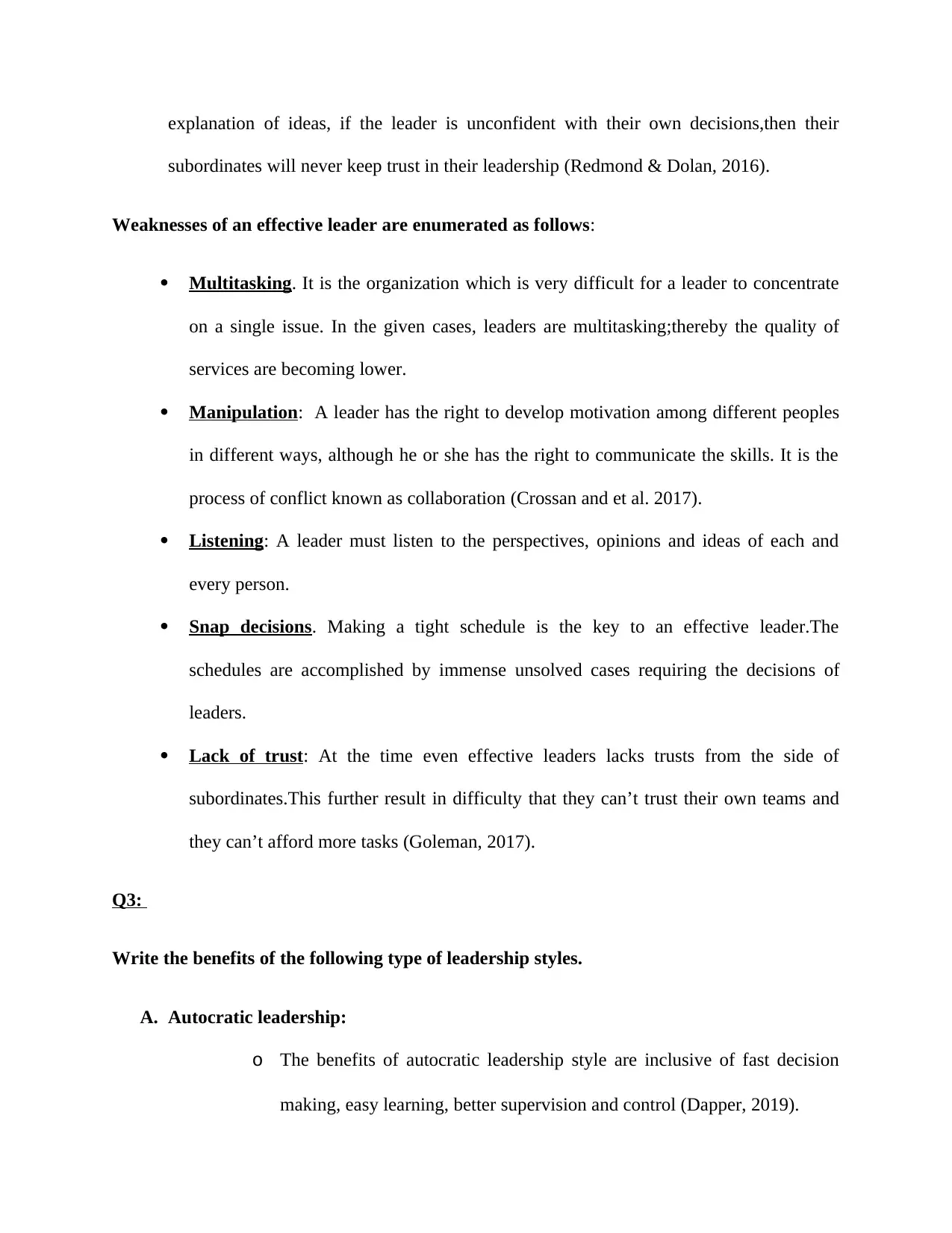
explanation of ideas, if the leader is unconfident with their own decisions,then their
subordinates will never keep trust in their leadership (Redmond & Dolan, 2016).
Weaknesses of an effective leader are enumerated as follows:
Multitasking. It is the organization which is very difficult for a leader to concentrate
on a single issue. In the given cases, leaders are multitasking;thereby the quality of
services are becoming lower.
Manipulation: A leader has the right to develop motivation among different peoples
in different ways, although he or she has the right to communicate the skills. It is the
process of conflict known as collaboration (Crossan and et al. 2017).
Listening: A leader must listen to the perspectives, opinions and ideas of each and
every person.
Snap decisions. Making a tight schedule is the key to an effective leader.The
schedules are accomplished by immense unsolved cases requiring the decisions of
leaders.
Lack of trust: At the time even effective leaders lacks trusts from the side of
subordinates.This further result in difficulty that they can’t trust their own teams and
they can’t afford more tasks (Goleman, 2017).
Q3:
Write the benefits of the following type of leadership styles.
A. Autocratic leadership:
o The benefits of autocratic leadership style are inclusive of fast decision
making, easy learning, better supervision and control (Dapper, 2019).
subordinates will never keep trust in their leadership (Redmond & Dolan, 2016).
Weaknesses of an effective leader are enumerated as follows:
Multitasking. It is the organization which is very difficult for a leader to concentrate
on a single issue. In the given cases, leaders are multitasking;thereby the quality of
services are becoming lower.
Manipulation: A leader has the right to develop motivation among different peoples
in different ways, although he or she has the right to communicate the skills. It is the
process of conflict known as collaboration (Crossan and et al. 2017).
Listening: A leader must listen to the perspectives, opinions and ideas of each and
every person.
Snap decisions. Making a tight schedule is the key to an effective leader.The
schedules are accomplished by immense unsolved cases requiring the decisions of
leaders.
Lack of trust: At the time even effective leaders lacks trusts from the side of
subordinates.This further result in difficulty that they can’t trust their own teams and
they can’t afford more tasks (Goleman, 2017).
Q3:
Write the benefits of the following type of leadership styles.
A. Autocratic leadership:
o The benefits of autocratic leadership style are inclusive of fast decision
making, easy learning, better supervision and control (Dapper, 2019).
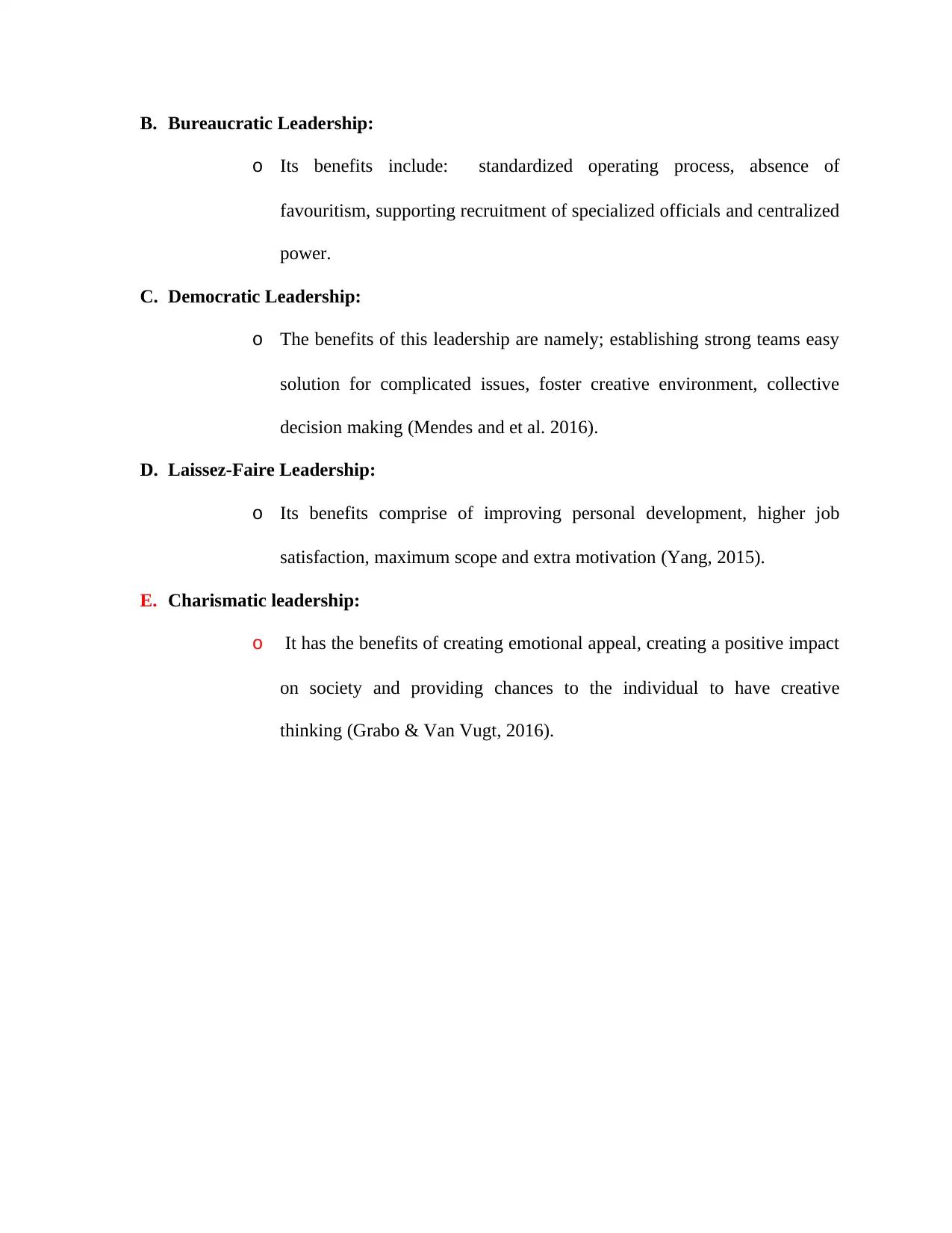
B. Bureaucratic Leadership:
o Its benefits include: standardized operating process, absence of
favouritism, supporting recruitment of specialized officials and centralized
power.
C. Democratic Leadership:
o The benefits of this leadership are namely; establishing strong teams easy
solution for complicated issues, foster creative environment, collective
decision making (Mendes and et al. 2016).
D. Laissez-Faire Leadership:
o Its benefits comprise of improving personal development, higher job
satisfaction, maximum scope and extra motivation (Yang, 2015).
E. Charismatic leadership:
o It has the benefits of creating emotional appeal, creating a positive impact
on society and providing chances to the individual to have creative
thinking (Grabo & Van Vugt, 2016).
o Its benefits include: standardized operating process, absence of
favouritism, supporting recruitment of specialized officials and centralized
power.
C. Democratic Leadership:
o The benefits of this leadership are namely; establishing strong teams easy
solution for complicated issues, foster creative environment, collective
decision making (Mendes and et al. 2016).
D. Laissez-Faire Leadership:
o Its benefits comprise of improving personal development, higher job
satisfaction, maximum scope and extra motivation (Yang, 2015).
E. Charismatic leadership:
o It has the benefits of creating emotional appeal, creating a positive impact
on society and providing chances to the individual to have creative
thinking (Grabo & Van Vugt, 2016).
⊘ This is a preview!⊘
Do you want full access?
Subscribe today to unlock all pages.

Trusted by 1+ million students worldwide

References
Bryson, J. M. (2018). Strategic planning for public and nonprofit organizations: A guide to
strengthening and sustaining organizational achievement. John Wiley & Sons.
Cashman, K. (2017). Leadership from the inside out: Becoming a leader for life. Berrett-Koehler
Publishers.
Cockburn, T., Smith, P. A., & Cockburn, G. A. (2019). Collaboration and Conflict in Three
Workplace Teams´ Projects. In Handbook of Research on Strategic Communication,
Leadership, and Conflict Management in Modern Organizations (pp. 52-85). IGI Global.
Crossan, M. M., Byrne, A., Seijts, G. H., Reno, M., Monzani, L., & Gandz, J. (2017). Toward a
framework of leader character in organizations. Journal of Management Studies, 54(7),
986-1018.
Dapper, R. E. E. (2019). Leadership Styles and Entrepreneurial Orientation. Leadership, 11(8).
86-101.
Ebrahimi Mehrabani, S., & Azmi Mohamad, N. (2015). The new approach to leadership skills
development (developing a model and measure). Journal of Management
Development, 34(7), 821-853.
Ford, R. C., Piccolo, R. F., & Ford, L. R. (2017). Strategies for building effective virtual teams:
Trust is key. Business Horizons, 60(1), 25-34.
Goleman, D. (2017). Leadership that gets results (Harvard business review classics). Harvard
Business Press.
Bryson, J. M. (2018). Strategic planning for public and nonprofit organizations: A guide to
strengthening and sustaining organizational achievement. John Wiley & Sons.
Cashman, K. (2017). Leadership from the inside out: Becoming a leader for life. Berrett-Koehler
Publishers.
Cockburn, T., Smith, P. A., & Cockburn, G. A. (2019). Collaboration and Conflict in Three
Workplace Teams´ Projects. In Handbook of Research on Strategic Communication,
Leadership, and Conflict Management in Modern Organizations (pp. 52-85). IGI Global.
Crossan, M. M., Byrne, A., Seijts, G. H., Reno, M., Monzani, L., & Gandz, J. (2017). Toward a
framework of leader character in organizations. Journal of Management Studies, 54(7),
986-1018.
Dapper, R. E. E. (2019). Leadership Styles and Entrepreneurial Orientation. Leadership, 11(8).
86-101.
Ebrahimi Mehrabani, S., & Azmi Mohamad, N. (2015). The new approach to leadership skills
development (developing a model and measure). Journal of Management
Development, 34(7), 821-853.
Ford, R. C., Piccolo, R. F., & Ford, L. R. (2017). Strategies for building effective virtual teams:
Trust is key. Business Horizons, 60(1), 25-34.
Goleman, D. (2017). Leadership that gets results (Harvard business review classics). Harvard
Business Press.
Paraphrase This Document
Need a fresh take? Get an instant paraphrase of this document with our AI Paraphraser
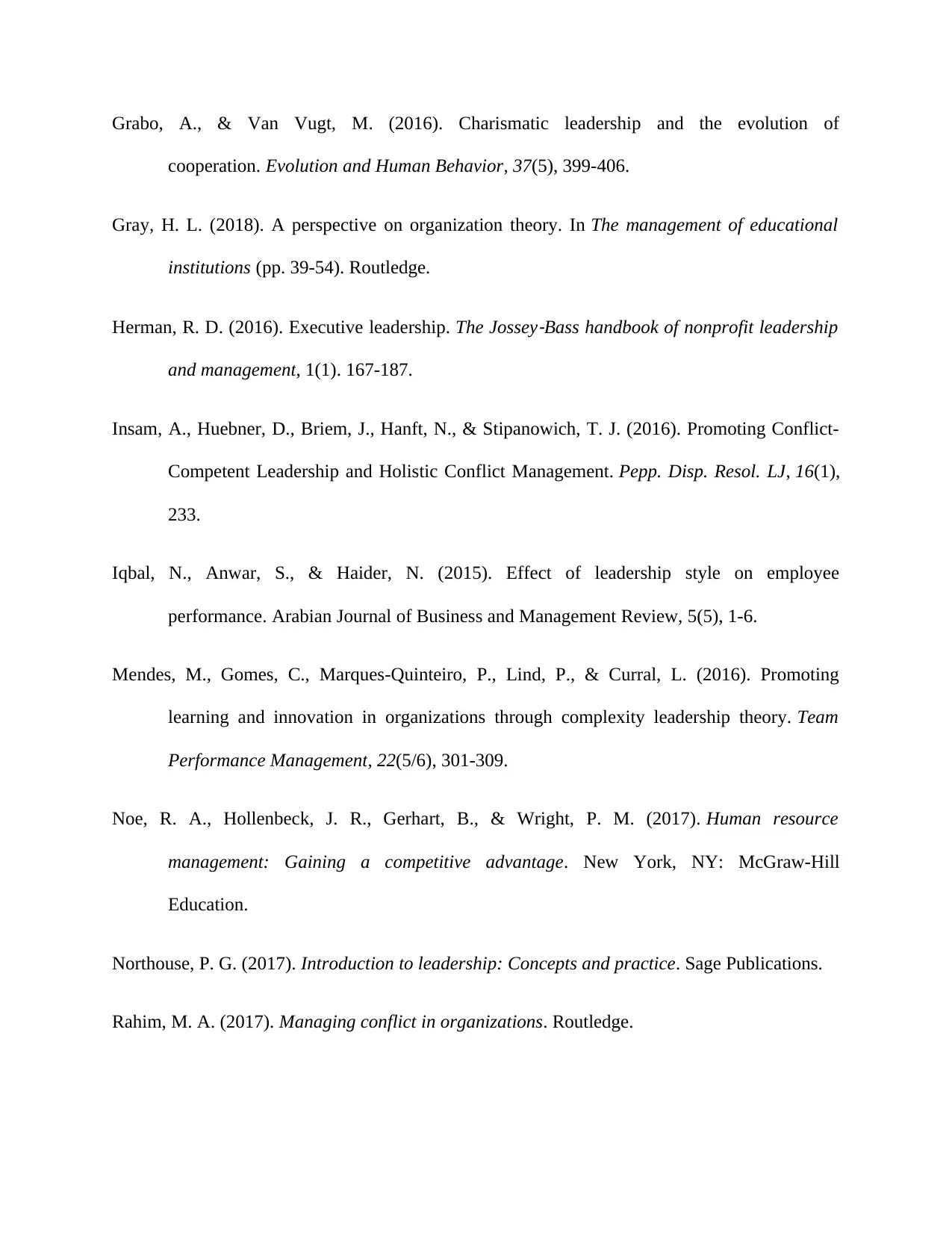
Grabo, A., & Van Vugt, M. (2016). Charismatic leadership and the evolution of
cooperation. Evolution and Human Behavior, 37(5), 399-406.
Gray, H. L. (2018). A perspective on organization theory. In The management of educational
institutions (pp. 39-54). Routledge.
Herman, R. D. (2016). Executive leadership. The Jossey
‐Bass handbook of nonprofit leadership
and management, 1(1). 167-187.
Insam, A., Huebner, D., Briem, J., Hanft, N., & Stipanowich, T. J. (2016). Promoting Conflict-
Competent Leadership and Holistic Conflict Management. Pepp. Disp. Resol. LJ, 16(1),
233.
Iqbal, N., Anwar, S., & Haider, N. (2015). Effect of leadership style on employee
performance. Arabian Journal of Business and Management Review, 5(5), 1-6.
Mendes, M., Gomes, C., Marques-Quinteiro, P., Lind, P., & Curral, L. (2016). Promoting
learning and innovation in organizations through complexity leadership theory. Team
Performance Management, 22(5/6), 301-309.
Noe, R. A., Hollenbeck, J. R., Gerhart, B., & Wright, P. M. (2017). Human resource
management: Gaining a competitive advantage. New York, NY: McGraw-Hill
Education.
Northouse, P. G. (2017). Introduction to leadership: Concepts and practice. Sage Publications.
Rahim, M. A. (2017). Managing conflict in organizations. Routledge.
cooperation. Evolution and Human Behavior, 37(5), 399-406.
Gray, H. L. (2018). A perspective on organization theory. In The management of educational
institutions (pp. 39-54). Routledge.
Herman, R. D. (2016). Executive leadership. The Jossey
‐Bass handbook of nonprofit leadership
and management, 1(1). 167-187.
Insam, A., Huebner, D., Briem, J., Hanft, N., & Stipanowich, T. J. (2016). Promoting Conflict-
Competent Leadership and Holistic Conflict Management. Pepp. Disp. Resol. LJ, 16(1),
233.
Iqbal, N., Anwar, S., & Haider, N. (2015). Effect of leadership style on employee
performance. Arabian Journal of Business and Management Review, 5(5), 1-6.
Mendes, M., Gomes, C., Marques-Quinteiro, P., Lind, P., & Curral, L. (2016). Promoting
learning and innovation in organizations through complexity leadership theory. Team
Performance Management, 22(5/6), 301-309.
Noe, R. A., Hollenbeck, J. R., Gerhart, B., & Wright, P. M. (2017). Human resource
management: Gaining a competitive advantage. New York, NY: McGraw-Hill
Education.
Northouse, P. G. (2017). Introduction to leadership: Concepts and practice. Sage Publications.
Rahim, M. A. (2017). Managing conflict in organizations. Routledge.
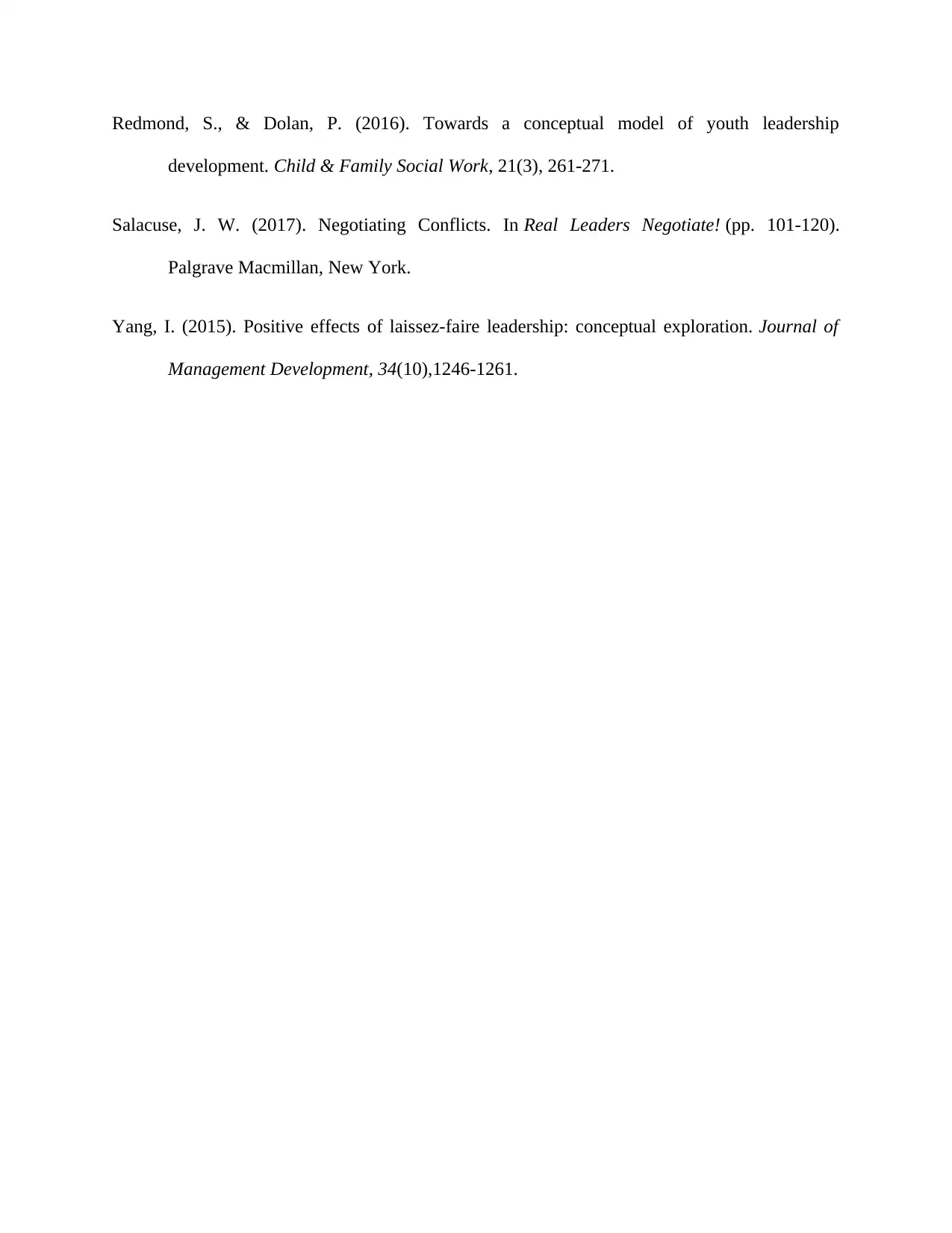
Redmond, S., & Dolan, P. (2016). Towards a conceptual model of youth leadership
development. Child & Family Social Work, 21(3), 261-271.
Salacuse, J. W. (2017). Negotiating Conflicts. In Real Leaders Negotiate! (pp. 101-120).
Palgrave Macmillan, New York.
Yang, I. (2015). Positive effects of laissez-faire leadership: conceptual exploration. Journal of
Management Development, 34(10),1246-1261.
development. Child & Family Social Work, 21(3), 261-271.
Salacuse, J. W. (2017). Negotiating Conflicts. In Real Leaders Negotiate! (pp. 101-120).
Palgrave Macmillan, New York.
Yang, I. (2015). Positive effects of laissez-faire leadership: conceptual exploration. Journal of
Management Development, 34(10),1246-1261.
⊘ This is a preview!⊘
Do you want full access?
Subscribe today to unlock all pages.

Trusted by 1+ million students worldwide
1 out of 12
Your All-in-One AI-Powered Toolkit for Academic Success.
+13062052269
info@desklib.com
Available 24*7 on WhatsApp / Email
![[object Object]](/_next/static/media/star-bottom.7253800d.svg)
Unlock your academic potential
Copyright © 2020–2025 A2Z Services. All Rights Reserved. Developed and managed by ZUCOL.